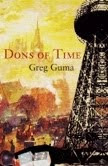Part 32 of Prisoners of the Real
In Sufism, Dionysus is described as a process of "deep understanding" or direct perception. In Zen, it is called kensho – to enter inside. And the I Ching, whose first hexagram refers to Apollonian power and energy, calls it K'un – the Receptive.
K'un, the second hexagram, is a series of broken lines representing the dark, primal power of yin, related both to devotion and the Earth. It is a perfect complement to the Creative, representing nature in contrast to spirit, earth in contrast to heaven, and the female in contrast to the male. Within the individual, it points toward the need for co-existence between the spiritual world and the world of the senses.
With the help of Dionysus, humanity can liberate itself from manipulative structures and transform the arrogant dragon into a receptive spirit: plurality can become unity, the gradual building of trust and love between all beings, with individual entities acknowledged as temporary forms filled with a single mind-energy. Planning can be matched by designing, sequence can be mated with synchronicity. In short, the isolated parts of the social body can be re-united as interdependent elements, equipotential within the whole.
This Dionysian force is a universal, collective and dynamic instinct within all human beings, the single substance within every system. It expresses itself through patterns of instinctual behavior, archetypes or motifs of the psyche pre-existent in the collective unconscious. Eternal repetition has engraved these archetypes into humanity's psychic constitution, not as images with content but, at least initially, as forms without content that represent the possibility of a certain kind of perception and action. The potential can be released through dreams and active imagination; although both have valuable uses in organizations, the latter can be more easily applied to social and work life.
Deliberate concentration can produce a group of fantasies – chance ideas, as yet unrealized possibilities. They can be considered through reflection, searched for their associations and material contexts. The result has been called inspiration and innovation. For Maslow it was primary creativity, for Noam Chomsky an "instinct for freedom," and Emerson called it transcendentalism. Whatever the name, it is the door of perception opening.
In Sufism, Dionysus is described as a process of "deep understanding" or direct perception. In Zen, it is called kensho – to enter inside. And the I Ching, whose first hexagram refers to Apollonian power and energy, calls it K'un – the Receptive.
K'un, the second hexagram, is a series of broken lines representing the dark, primal power of yin, related both to devotion and the Earth. It is a perfect complement to the Creative, representing nature in contrast to spirit, earth in contrast to heaven, and the female in contrast to the male. Within the individual, it points toward the need for co-existence between the spiritual world and the world of the senses.
With the help of Dionysus, humanity can liberate itself from manipulative structures and transform the arrogant dragon into a receptive spirit: plurality can become unity, the gradual building of trust and love between all beings, with individual entities acknowledged as temporary forms filled with a single mind-energy. Planning can be matched by designing, sequence can be mated with synchronicity. In short, the isolated parts of the social body can be re-united as interdependent elements, equipotential within the whole.
This Dionysian force is a universal, collective and dynamic instinct within all human beings, the single substance within every system. It expresses itself through patterns of instinctual behavior, archetypes or motifs of the psyche pre-existent in the collective unconscious. Eternal repetition has engraved these archetypes into humanity's psychic constitution, not as images with content but, at least initially, as forms without content that represent the possibility of a certain kind of perception and action. The potential can be released through dreams and active imagination; although both have valuable uses in organizations, the latter can be more easily applied to social and work life.
Deliberate concentration can produce a group of fantasies – chance ideas, as yet unrealized possibilities. They can be considered through reflection, searched for their associations and material contexts. The result has been called inspiration and innovation. For Maslow it was primary creativity, for Noam Chomsky an "instinct for freedom," and Emerson called it transcendentalism. Whatever the name, it is the door of perception opening.
*
**
***
**
***
The Dionysian collective has weathered a chilling winter of rationalism. Violated in the seventeenth century. dismembered by skeptics in the Age of Reason, its essence was given a ritual burial as rationalized humanity sacrificed itself to the clockwork deity it had constructed. But Dionysus is about to return, and arrogant dragons will relearn the meaning of annihilation. Historical circumstances, environmental consequences and instinctual will have combined as humanity gazes over the edge of history at a 2000 year cycle that began with Pythagoras, and is ending with the dictatorship of structures and the fetishism of the "real."
Throughout this cycle, and particularly for the last four hundred years, our guardians of order have been rational managers who have turned further outward and upward. The One has become a digit, objectified and classified by purveyors of data. Scientists have built a routinized world through a logical sequence, a progression that has simultaneously destroyed intuition and myth for the greater glory of reason.
In reaching to command and shape natural forces, other living beings and humanity, these managers have smothered their instincts in a machine-made blanket of facts. Total systemic predictability has been an imaginary carrot dangled from the calibrated stick of science. As a result, tools have been used to shape human beings in an image that appeared to Renaissance philosophers, astronomers, mathematicians, and certainty-bound mechanics. In the 20th century, the reflex doctrine of controlled and controlling humanity became the central prophecy of our age.
But as the I Ching suggests, the current standstill will not last. "First standstill," predicts the oracle, "then good fortune." Rational leaders have made necessity the commanding father of spontaneous invention. But human beings who discover within themselves the potential of Dionysus can turn the inverted pyramid back upon its base. In doing so, they can find wisdom and creative intellect, using Earth as the foundation for understanding higher things. They can make invention the tolerant mother of order and necessity, and through their intuitive methods create a web of Dionysian collectives that will regenerate the world.
Throughout this cycle, and particularly for the last four hundred years, our guardians of order have been rational managers who have turned further outward and upward. The One has become a digit, objectified and classified by purveyors of data. Scientists have built a routinized world through a logical sequence, a progression that has simultaneously destroyed intuition and myth for the greater glory of reason.
In reaching to command and shape natural forces, other living beings and humanity, these managers have smothered their instincts in a machine-made blanket of facts. Total systemic predictability has been an imaginary carrot dangled from the calibrated stick of science. As a result, tools have been used to shape human beings in an image that appeared to Renaissance philosophers, astronomers, mathematicians, and certainty-bound mechanics. In the 20th century, the reflex doctrine of controlled and controlling humanity became the central prophecy of our age.
But as the I Ching suggests, the current standstill will not last. "First standstill," predicts the oracle, "then good fortune." Rational leaders have made necessity the commanding father of spontaneous invention. But human beings who discover within themselves the potential of Dionysus can turn the inverted pyramid back upon its base. In doing so, they can find wisdom and creative intellect, using Earth as the foundation for understanding higher things. They can make invention the tolerant mother of order and necessity, and through their intuitive methods create a web of Dionysian collectives that will regenerate the world.
*
**
***
**
***
Dionysian leaders use artistic methods to invent structures of reality. Although they acknowledge that both scientific and artistic processes have worth, they de-emphasize logical reasoning and deduction and focus on metaphorical thinking. Their interest is not definition but discovery.
Metaphor is a ceaseless movement of association – of ideas, experiences and tensions. It swings in two directions as one object is related to another, one phenomenon, experience, behavior, or personality. Pairs define one another and emerge mutually. Reality is related to unreality and becomes partially abstract. Unreality – the inexpressible – becomes more tangible. Through their fusion the two create a new reality with an evolved nature.
Metaphorical method relies upon both sense experience and spontaneous creation. The first, observation by the senses, is a traditional scientific tool. When combined with abstract thought it leads to scientific theory. Used in concert with reflection – that is, purposeful concentration as a vehicle of spontaneity – it instead produces artistic discovery.
Dionysian beings use metaphor for creative activity rather than abstract reasoning, suspending their routines as they deal with the "real world." They remain receptive to the subject of group action, and to the various members of their group. Though they may be leaders, they don’t consider themselves "professionals" or executives within a hierarchy. They act instead as integrated group members whose specific contribution is their ability to create images of whole systems, and to initiate change while maintaining a harmony of meaning between their groups and the environment.
The intuitive approach places the leader within the subject. She "sees" it, coincides with its unique aspects. She remains mobile within a shifting organizational framework, using her skill to provide others with images, expressions to which they can respond. Another crucial aspect is the maintenance of ethical sensitivity. Dionysian leaders are value-conscious adhesive bonds within their groups. Others may monitor output on a timely basis, but the primary concern of the Dionysian leader is input.
In Dionysian collectives structure emerges gradually as a by-product of activity. History combines with the sum of individual perceptions to shape the future of the group. The leader is a generalist. Others may move toward specialization as they increase their awareness of interpersonal relations and the meshing of individual and group purposes. The leader assists them in shaping and reshaping their group meaning, and varying their individual experiences. Although leaders assume "operational" tasks along with everyone else, their central assignment is the continual posing of questions that promote spontaneity and change. Rather than relying on analysis – the orderly sequencing of thoughts – they use association – the relationship between ideas.
Taken together, these approaches make the leadership role a force away from centralization. Large systems are broken into more functional units, each one operationally autonomous yet sensitive to the infinitely varying purposes of other groups. It is at the level of purpose that Dionysian collectives relate, and their leaders open the gates for the transfer for energy.
The assumption that unifies these entities is that belief regulates structure. Dionysian leaders expand the limits of belief and restrict the limits of resulting structures.
Next: The Turning Point
Metaphor is a ceaseless movement of association – of ideas, experiences and tensions. It swings in two directions as one object is related to another, one phenomenon, experience, behavior, or personality. Pairs define one another and emerge mutually. Reality is related to unreality and becomes partially abstract. Unreality – the inexpressible – becomes more tangible. Through their fusion the two create a new reality with an evolved nature.
Metaphorical method relies upon both sense experience and spontaneous creation. The first, observation by the senses, is a traditional scientific tool. When combined with abstract thought it leads to scientific theory. Used in concert with reflection – that is, purposeful concentration as a vehicle of spontaneity – it instead produces artistic discovery.
Dionysian beings use metaphor for creative activity rather than abstract reasoning, suspending their routines as they deal with the "real world." They remain receptive to the subject of group action, and to the various members of their group. Though they may be leaders, they don’t consider themselves "professionals" or executives within a hierarchy. They act instead as integrated group members whose specific contribution is their ability to create images of whole systems, and to initiate change while maintaining a harmony of meaning between their groups and the environment.
The intuitive approach places the leader within the subject. She "sees" it, coincides with its unique aspects. She remains mobile within a shifting organizational framework, using her skill to provide others with images, expressions to which they can respond. Another crucial aspect is the maintenance of ethical sensitivity. Dionysian leaders are value-conscious adhesive bonds within their groups. Others may monitor output on a timely basis, but the primary concern of the Dionysian leader is input.
In Dionysian collectives structure emerges gradually as a by-product of activity. History combines with the sum of individual perceptions to shape the future of the group. The leader is a generalist. Others may move toward specialization as they increase their awareness of interpersonal relations and the meshing of individual and group purposes. The leader assists them in shaping and reshaping their group meaning, and varying their individual experiences. Although leaders assume "operational" tasks along with everyone else, their central assignment is the continual posing of questions that promote spontaneity and change. Rather than relying on analysis – the orderly sequencing of thoughts – they use association – the relationship between ideas.
Taken together, these approaches make the leadership role a force away from centralization. Large systems are broken into more functional units, each one operationally autonomous yet sensitive to the infinitely varying purposes of other groups. It is at the level of purpose that Dionysian collectives relate, and their leaders open the gates for the transfer for energy.
The assumption that unifies these entities is that belief regulates structure. Dionysian leaders expand the limits of belief and restrict the limits of resulting structures.
Next: The Turning Point
To read other chapters, go to Prisoners of the Real: An Odyssey































No comments:
Post a Comment